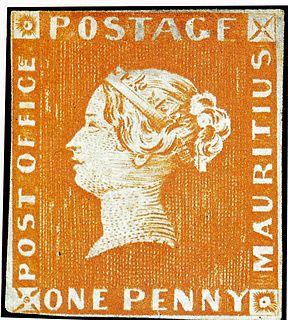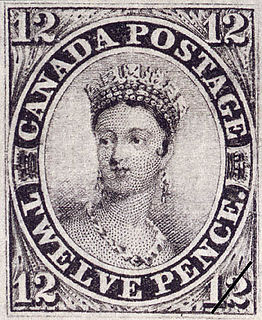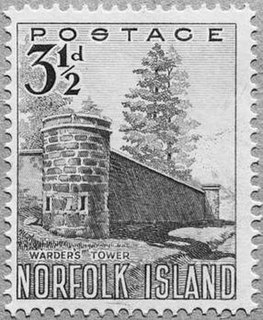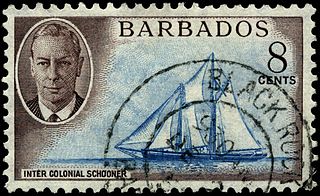
The Penny Black was the world's first adhesive postage stamp used in a public postal system. It was first issued in the United Kingdom, on 1 May 1840, but was not valid for use until 6 May. The stamp features a profile of Queen Victoria.

The Penny Red was a British postage stamp, issued in 1841. It succeeded the Penny Black and continued as the main type of postage stamp in the United Kingdom of Great Britain and Ireland until 1879, with only minor changes to the design during that time. The colour was changed from black to red because of difficulty in seeing a cancellation mark on the Penny Black; a black cancellation mark was readily visible on a Penny Red.
This is a list of philatelic topics.

Postage stamps and postal history of Great Britain surveys postal history from the United Kingdom and the postage stamps issued by that country and its various historical territories until the present day.

The Inverted Swan, a 4-pence blue postage stamp issued in 1855 by Western Australia, was one of the world's first invert errors. Technically, it is the frame that is inverted, not the image of the swan, but it has become commonly known as the Inverted Swan.

This is an overview of the postage stamps and postal history of Australia.

This is a survey of the postage stamps and postal history of the Northern Nigeria Protectorate.

The Mauritius "Post Office" stamps were issued by the British Colony Mauritius in September 1847, in two denominations: an orange-red one penny (1d) and a deep blue two pence (2d). Their name comes from the wording on the stamps reading "Post Office", which was soon changed in the next issue to "Post Paid". They are among the rarest postage stamps in the world.

In philately, an invert error occurs when part of a stamp is printed upside-down. Inverts are perhaps the most spectacular of postage stamp errors, not only because of their striking visual appearance, but because some are quite rare, and highly valued by stamp collectors.

The Inverted Head Four Annas of India is a postage stamp prized by collectors. The 1854 first issues of India included a Four Annas value in red and blue. It was one of the world's first multicolored stamps; the Basel Dove preceded it by nine years. However, an invert error occurred during production, showing the head "upside down."

The Chalon Head is the name of a number of postage stamp series whose illustration was inspired by a portrait of Queen Victoria by Alfred Edward Chalon (1780–1860).

This is a survey of the postage stamps and postal history of Jamaica.

Mauritius, a small island in the southwest Indian Ocean, is important to the world of philately for a number of reasons. Its first two postage stamps issued in 1847, called the "Post Office" stamps, are of legendary rarity and value. They were the first stamps issued in any part of the British Empire outside of Great Britain. The unique cover bearing both “Post Office” stamps has been called "la pièce de résistance de toute la philatélie" or "the greatest item in all philately". The cover was sold at auction, in Zurich, on 3 November 1993, for 5.75 million Swiss francs, the equivalent of about $4 million – the highest price ever paid for a single philatelic item up to that time. In addition, Mauritius is well known for the subsequent locally produced issues known as "primitives," also prized by collectors.

The postage stamps and postal history of Norfolk Island depended on Australia until 1947, when the island, an Australian territory since 1914, received its own stamps and postal autonomy.

This is a survey of the postage stamps and postal history of Barbados.

Western Australia, a state of Australia and formerly a British colony, established its postal service soon after the British settled in 1829; in December of that year, Fremantle's harbourmaster was appointed postmaster. A post office in Albany opened on 14 October 1834, and the main post office moved to Perth in 1835.

This is a survey of the postage stamps and postal history of Tasmania, a former British colony that is now part of Australia.

This is a survey of the postage stamps and postal history of South Australia, a former British colony that is now part of Australia.
William Reeve Rundell, sometimes Reeves, was an Australian postal officer.
















